
Audi Sound Concept is the most advanced project of the entertainment development engineers in Ingolstadt. The project is internally dubbed the Audi Sound Concept and is being tested on a Q7 model. This design boasts an insane 62 speakers in the vehicle, consisting of five woofers, five tweeters and fifty-two mid-range speakers in the instrument panel beneath the windshield, in the roof pillars, and in the doors.
The system consists of five tweeters spread between the dashboard and the rear seating area, a woofer in each of the four doors, a single subwoofer out back, and a whopping 52 midrange speakers wrapping the perimeter of the cabin and enveloping the passengers in 360 degrees of sound. You're definitely not going to want to crank this rig up to 11.
Moreover, five units are integrated into each door sill, thanks to modifications that included cutouts in the sheet metal, new bezels and lower interior door release handles.
Development of the system took place in both the €100,000 listening facility and the €10 million audio lab at Audi HQ in Ingolstadt.
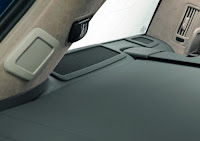
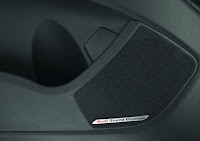
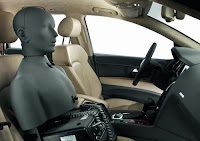
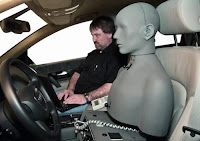

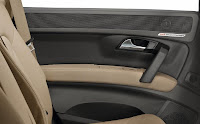
Press Release
New approaches to perfect sound - Hi-fi expertise at Audi
High-end quality for listening pleasure is a field of technology that is becoming increasingly important. Audi is taking the lead in the advancement of this technology. Audi's successful collaboration with premium suppliers Bang & Olufsen and Bose is already setting standards, and the Audi development engineers have also established broad-based proprietary know-how independent of these partnerships. Their latest project takes an entirely new technical approach - and could turn out to be the next revolution in the hi-fi sector.
62 speakers: the Audi Sound Concept project
Peter Gleim's eyes light up when he cranks up the volume. The engineer works in Infotainment Development at Audi in Ingolstadt, where he heads the Audi Sound Concept project. His test subject is a Q7: Standard on the outside, interior modifications have transformed it into a rolling hi-fi studio that takes a radically new approach.
The idea behind Audi Sound Concept is a physical principle called wave field synthesis, which states that the front of any individual wave can also be considered as superposition of individual waves. In the world of acoustics this means that a sound wave can be recreated by a multiplicity of small sound sources placed closely adjacent to one another along the wave front.
The principle was first put into practice by Dutch scientists in the late 1980s, and it can be experienced today in a movie theater in Ilmenau, in the German state of Thuringia. Each of the 192 individual speakers at the Linden Lichtspiele movie theater is driven separately by a fast computer - at the precise moment in which the virtual wave front would pass through its point in space. Some signals are delayed by milliseconds, depending on the location of the speaker. The result is fascinating: Each moviegoer experiences perfect audio spatialization in optimal sound.
One of the driving forces in the field of wave field synthesis is the Fraunhofer Institute for Digital Media Technology (IDMT) in Ilmenau. Audi began its development work in collaboration with the IDMT five years ago. The current status of the project is the Q7 prototype, which is parked in a workshop. A powerful amplifier takes up most of the space in the luggage compartment, and thick cables connect it to three PCs.
Installed in the Audi Q7 are 62 speakers - five woofers and five tweeters plus 52 mid-range speakers in the instrument panel beneath the windshield, in the roof pillars and in the doors. Five units are integrated into each door sill - with Audi-typical perfect workmanship. Specialists made cutouts in the sheet metal, fabricated new bezels and lowered the interior door release handles.
"Prepare to be amazed," says Gleim, as his eyes light up and he cranks up the volume. A sound like a thunderhead issues from the speakers - an artful mix of music, traffic noise and animal sounds. A female narrator guides the listener through the acoustic hubbub, dancing past the listener on the right and at other times on the left. The whole time the listener's ears are surrounded by the sounds of driving cars and roaring lions. A marching band seems to march from side to side through the Q7 before finally a helicopter flies a lap around the cabin below the headliner.
"That is specially created wave field material," says Gleim, "comprising up to 32 tracks, with specific spatial information for each of those tracks." There are no corresponding audio media available on the market because there are no playback devices, either. A few film studios are already producing films with the method, however."
New stereo sound: the wide virtual stage
Wave field synthesis is not dependent on special material to demonstrate its strengths, however. It also coaxes entirely new acoustic images out of conventional stereo signals. As Gleim explains, "We can simulate any wave front. With stereo, we can generate a sound as if the two speakers were located far outside the car. And we can also add any desired spatial impression computationally - not as a sound effect, but as a mathematically precise simulation."
The sample for this is also very convincing. The vocals come from far off to the left, seemingly from the corner of the workshop, with the guitar coming from the other corner. This impression remains the same regardless of whether the listener is behind the wheel or on the back right seat of the Audi Q7. And sound quality is always first class - with sparkling trebles, crystal-clear midrange and dry bass. Even the slight buzz as the guitarist's fingers hit the strings makes its way to the ear with extreme precision.
"Our goal was to show what is technically feasible; to explore the limits," explains Denis Credé, Head of Sound Development at Audi. "What we are learning will be integrated into the sound systems of tomorrow. It's like with racing: A lot of what is first tried out on the race tracks of this world later shows up in modified in production vehicles. The Audi Sound Concept project is like racing for sound systems."
Wide-ranging know-how: Entertainment Development at Audi
Audi Sound Concept is the most advanced project of the entertainment development engineers in Ingolstadt. Audi has accumulated broad-based know-how in hi-fi technology in just a short time. The brand began collaborating with the upscale American supplier Bose a good twenty years ago; the collaboration with Bang & Olufsen began around the turn of the millennium.
Audi began offering the advanced sound system from the Danish sound wizards in the A8 luxury sedan in fall 2005. The 14 active speakers, including two acoustic lenses with anodized aluminum grilles, and 1,100 watts of amplifier power brought high-end sound to the automobile direct from the factory for the first time. The openly proclaimed collaboration between the two companies was another first in the European automobile industry. It proved to be a tremendous success for both sides - the advanced sound system has a penetration rate of greater than 10 percent in both models, the A8 and Q7, in which it is available.
If a new Audi model is to be equipped with a new premium or advanced sound system, the development work is performed primarily at Bose or Bang & Olufsen. The Audi engineers prepare precise requirement specifications in which the system layout - the type, number and installation location of the speakers - plus the speaker characteristics, the design of the amplifier and a target sound appropriate for the vehicle are defined.
Prototype vehicles are sent to Esslingen, Germany, and Struer, Denmark, where the partners work on the speakers, enclosures, amplifiers and acoustic algorithms. The last step is fine-tuning the sound, which is performed together with the Audi specialists in Ingolstadt. The "Sound Commission," a body comprising representatives from all units of the company, is responsible for final acceptance and approval.
How close does the high-end sound in a new Audi A8 come to the reality of the recording? "The determining factors are always the installation locations in the car and the quality of the components," explains Gleim. "When you order a car with the advanced sound system, you get the best speakers available anywhere. Many of them have membranes made of a fiberglass composite, which has a very natural and linear sound."
Pure sound is technically feasible - but not desired. "A linear frequency response in the car would be boring," says Gleim. The tight interior does not allow the sound to spread out like in a living room. Cushions and upholstery absorb it, which is why the low frequencies must be overdriven to a certain extent. The electronic fine-tuning - the tweaking of the algorithms in the sound processor - handles this.
"We deliver a certain fun factor with our compact and sporty models," explains the sound development engineer. "In the A8 and Q7, however, the sound is more subtle and natural. There is no ultimate ideal, though, because each person perceives sound in their own unique way."
Proprietary development: the Audi sound systems
Below the high-end and premium systems, Audi offers additional systems such as the Audi sound system, which also uses impressive technology to produce excellent sound quality. Because Audi alone is responsible for the design and tuning of these systems, the development engineers have developed an extensive foundation of expertise.
The Electronics Center established at the Ingolstadt plant in 2003 includes a sound laboratory, where the sound systems undergo rigorous testing during the development phase. The engineers test the speakers and amplifiers offered by the suppliers, beginning with the very first sample level and assess the quality delivered, in part by means of exhaustive listening comparisons.
The laboratory features equipment valued at nearly €10 million - from the microphones and the special amplifier test bed custom-developed to Audi specifications to the laser vibrometer. The latter uses a laser to scan the surface vibrations that occur on the speaker membrane, the speaker housing or the door in which the speaker is installed.
The color graphics produced precisely indicate if the membrane does not oscillate properly across its entire surface. "Weaknesses in a speaker are very often a simple question of design," says Gleim's colleague, Wolfram Jähn. "In many cases, the manufacturer can resolve these with minor changes, such as details of the curvature or the overlap between the paper and the rubber at the bead."
Speakers are analyzed at the Audi sound laboratory in a testing room, which is a room-in-room construction. The testing room is mounted on thick elastomer bearings and is completely decoupled from the rest of the building. An absolute necessity given its direct proximity to a roller dynamometer.
All six sides of the testing room feature large fiberglass wedges covered in silk that break up the sound. A floating wire lattice serves as the floor.
The testing room is acoustically dead - the human voice loses its richness here. The room is also often used to refine operating noises in the cabin, i.e., to fine tune clicking rotary knobs and switches. "As far as we know, none of our competitors have such a facility," says Jähn.
The listening room: resetting your ears
Whereas the testing room is used for mathematical analysis, the adjacent listening room is tailored for the subjective experience. It, too, is an acoustically optimized room-in-room construction - the special wooden double walls backed with insulation only allow the linear reflections desired. The precisely calibrated, high-end sound system installed here costs around €100,000 and its tube-based end stages are the size of small refrigerators.
"The listening room is our acoustic magnifying glass," explains Jähn, "where we check what really is on a CD or DVD. This is important because your ears quickly get used to a sound and sometimes interpret errors as interesting effects. We test our sample speakers blind. We can compare them to the optimum and reset our ears."
Thanks to these detailed tests and comparisons, the sound development engineers at Audi can define detailed specifications for the speaker suppliers.
Another element for success is the tight networking between Technical Development, Production and Quality Assurance at Audi. This enables requirements from daily production work and the real-world customer experience to flow into the development of new sound systems.
The quality of the sound systems has gotten significantly better in recent years as a result, according to Gleim. And the engineers are constantly learning - at a rapid pace, day-in, day-out. Audi will further strengthen its leadership position in the high-end sector.
Source URL: https://hayleyatwellstuff.blogspot.com/2010/06/audi-sound-concept-features-62-speakers.html
Visit hayley atwell for Daily Updated Hairstyles Collection










